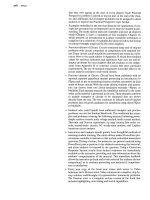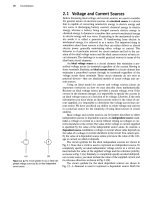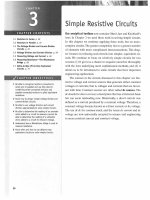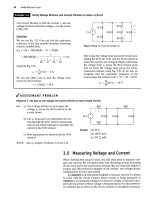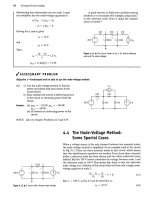Electric Circuits, 9th Edition P13 potx
Bạn đang xem bản rút gọn của tài liệu. Xem và tải ngay bản đầy đủ của tài liệu tại đây (299 KB, 10 trang )
96 Techniques of Circuit Analysis
Substituting this relationship into the node 2 equa-
tion simplifies the two node-voltage equations to
0.75vi
- 0.2¾ =
—V\ + 1.6¾¾
=
Solving for V\ and v
2
gives
t>i = 16 V
and
v
2
= 10 V.
Then,
16 - 10
i. = =
10,
=
0.
1 9 L
5
Psn = (1-44)(5) = 7.2 W.
A good exercise to build your problem-solving
intuition is to reconsider this example, using node 2
as the reference node. Does it make the analysis
easier or harder?
20 V
Figure 4.11 A
The
circuit shown in
Fig.
4.10, with a reference
node and the
node
voltages.
^/ASSESSMENT PROBLEM
Objective 1—Understand and be able to use the node-voltage method
4.3 a) Use the node-voltage method to find the
power associated with each source in the
circuit shown,
b) State whether the source is delivering power
to the circuit or extracting power from the
circuit.
Answer: (a) p
50
v =
_
150 W,/>
3/l
= -144 W,
p
5A
= -80W;
(b) all sources are delivering power to the
circuit.
NOTE: Also try Chapter Problems 4.17 and 4.19,
50 V
100 V
5A
Figure 4.12 A
A
circuit with a known node voltage.
4.4 The Node-Voltage Method:
Some Special Cases
When a voltage source is the only element between two essential nodes,
the node-voltage method is simplified. As an example, look at the circuit
in Fig. 4.12. There are three essential nodes in this circuit, which means
that two simultaneous equations are needed. From these three essential
nodes,
a reference node has been chosen and two other nodes have been
labeled. But the 100 V source constrains the voltage between node 1 and
the reference node to 100 V. This means that there is only one unknown
node voltage (v
2
). Solution of this circuit thus involves only a single node-
voltage equation at node 2:
v
2
- v
x
, v
2
10
+
50
0.
But V\ = 100 V, so Eq. 4.7 can be solved for v
2
:
v
2
= 125 V.
(4.7)
(4.8)
4.4 The Node-Voltage Method:
Some
Special
Cases
97
Knowing v
2
, we can calculate the current in every branch. You should ver-
ify that the current into node 1 in the branch containing the independent
voltage source is 1.5 A.
In general, when you use the node-voltage method to solve circuits
that have voltage sources connected directly between essential nodes, the
number of unknown node voltages is reduced. The reason is that, when-
ever a voltage source connects two essential nodes, it constrains the differ-
ence between the node voltages at these nodes to equal the voltage of the
source. Taking the time to see if you can reduce the number of unknowns
in this way will simplify circuit analysis.
Suppose that the circuit shown in Fig. 4.13 is to be analyzed using the
node-voltage method. The circuit contains four essential nodes, so we
anticipate writing three node-voltage equations. However, two essential
nodes are connected by an independent voltage source, and two other
essential nodes are connected by a current-controlled dependent voltage
source. Hence, there actually is only one unknown node voltage.
Choosing which node to use as the reference node involves several
possibilities. Either node on each side of the dependent voltage source
looks attractive because, if chosen, one of the node voltages would be
known to be either 4-1()/^ (left node is the reference) or -10^ (right node
is the reference).The lower node looks even better because one node volt-
age is immediately known (50 V) and five branches terminate there. We
therefore opt for the lower node as the reference.
Figure 4.14 shows the redrawn circuit, with the reference node flagged
and the node voltages defined.
Also,
we introduce the current i because we
cannot express the current in the dependent voltage source branch as a
function of the node voltages v
2
and v$. Thus, at node 2
Vl
v
\ V
2
(4.9)
Figure 4.13 •
A
circuit with a dependent voltage
source connected between nodes.
and at node 3
Figure 4.14 • The circuit shown in Fig. 4.13. with the
selected node voltages defined.
v
3
100
i - 4 = 0.
(4.10)
We eliminate i simply by adding Eqs. 4.9 and 4.10 to get
V-) — V\ V
2
V-x
— + — + ^ 4 = 0.
5 50 100
(4.11)
The Concept of a Supernode
Equation 4.11 may be written directly, without resorting to the interme-
diate step represented by Eqs. 4.9 and 4.10. To do so, we consider nodes 2
and 3 to be a single node and simply sum the currents away from the
node in terms of the node voltages v
2
and v
3
. Figure 4.15 illustrates
this approach.
When a voltage source is between two essential nodes, we can com-
bine those nodes to form a supernode. Obviously, Kirchhoff s current
law must hold for the supernode. In Fig. 4.15, starting with the 5 il
branch and moving counterclockwise around the supernode, we gener-
ate the equation
lh
»i
+ — + — - 4 = 0,
50 100
(4.12)
Figure 4.15 • Considering nodes
2
and
3
to be a
supernode.
98 Techniques of Circuit Analysis
which is identical to Eq. 4.11. Creating a supernode at nodes 2 and 3 has
made the task of analyzing this circuit easier. It is therefore always worth tak-
ing the time to look for this type of shortcut before writing any equations.
After Eq. 4.12 has been derived, the next step is to reduce the expres-
sion to a single unknown node voltage. First we eliminate v
x
from the
equation because we know that v
x
= 50 V. Next we express i>
3
as a func-
tion of vy.
t>
3
= V
2
+ 10/^.
(4.13)
We now express the current controlling the dependent voltage source as a
function of the node voltages:
Vi - 50
H
(4.14)
Figure 4.16 •
The
transistor amplifier circuit
shown
in
Fig.
2.24.
Using Eqs. 4.13 and 4.14 and v
{
= 50 V reduces Eq. 4.12 to
111 10
«
2
(0.25) = 15,
v
2
= 60 V.
From Eqs. 4.13 and 4.14:
60-50
i* = z = 2 A,
v
%
= 60 + 20 = 80 V.
Figure 4.17 •
The
circuit shown in Fig. 4.16, with
voltages and the supernode identified.
Node-Voltage Analysis of the Amplifier Circuit
Let's use the node-voltage method to analyze the circuit first introduced
in Section 2.5 and shown again in Fig. 4.16.
When we used the branch-current method of analysis in Section 2.5,
we faced the task of writing and solving six simultaneous equations. Here
we will show how nodal analysis can simplify our task.
The circuit has four essential nodes: Nodes a and d are connected by
an independent voltage source as are nodes b and c. Therefore the prob-
lem reduces to finding a single unknown node voltage, because
(n
e
-1)-2 = 1. Using d as the reference node, combine nodes b and c
into a supernode, label the voltage drop across R
2
as v
b
, and label the volt-
age drop across R
E
as v
c
, as shown in Fig.
4.17.
Then,
^b
v
b -
v
cc v^
R
2
R\ RE
&B = 0.
We now eliminate both v
c
and i
B
from Eq. 4.15 by noting that
v
c
= (h + (^B)RE^
v
c
= v
h
- V
{)
.
(4.15)
(4.16)
(4.17)
4.5
Introduction
to the
Mesh-Current
Method
99
Substituting Eqs. 4.16 and 4.17 into Eq. 4.15 yields
v
b
J_
_L i
R
{
+
R
2
+
(1 + (3)R
E
V
cc
Vr
Ri 0 + P)RE
Solving Eq. 4.18 for ?;
h
yields
VccMI + WE + V0R1R2
R
t
R
2
+ (1+ (3)R
E
(R
]
+ R
2
)
v
b
=
(4.18)
(4.19)
Using the node-voltage method to analyze this circuit reduces the prob-
lem from manipulating six simultaneous equations (see Problem 2.27) to
manipulating three simultaneous equations. You should verify that, when
Eq. 4.19 is combined with
Eqs.
4.16 and 4.17, the solution for
i&
is identical
to Eq.
2.25.
(See Problem 4.30.)
^ASSESSMENT
PROBLEMS
Objective 1—Understand and be able to use the node-voltage method
4.4 Use the node-voltage method to find v
a
in the
circuit shown.
30 0
-AA/V-
io a
10V
Answer: 24 V.
4.5 Use the node-voltage method to find v in the
circuit shown.
Answer: 8 V.
4.6 Use the node-voltage method to find v\ in the
circuit shown.
20 ft
'
!
,^40ft
20 i
A
Answer: 48 V.
NOTE: Also try Chapter Problems 4.24, 4.26, and 4.27.
4.5 Introduction to the
Mesh-Current Method
As stated in Section
4.1,
the mesh-current method of circuit analysis enables
us to describe a circuit in terms of b
e
— (n
e
- 1) equations. Recall that a
mesh is a loop with no other loops inside
it.
The circuit in
Fig.
4.1
(b) is shown
again in
Fig.
4.18,
with current arrows inside each loop to distinguish it. Recall
F1gure 4<18 A The drcu
|
t shown in Fig 41
^
t witn the
also that the mesh-current method is applicable only to planar circuits. The
m
esh currents defined.
100 Techniques of Circuit Analysis
Figure 4.19 • A circuit used to illustrate development
of the mesh-current method of circuit analysis.
circuit in Fig. 4.18 contains seven essential branches where the current is
unknown and four essential
nodes.
Therefore, to solve it via the mesh-current
method, we must write four [7 -(4- 1)] mesh-current equations.
A mesh current is the current that exists only in the perimeter of a
mesh. On a circuit diagram it appears as either a closed solid line or an
almost-closed solid line that follows the perimeter of the appropriate
mesh. An arrowhead on the solid line indicates the reference direction for
the mesh current. Figure 4.18 shows the four mesh currents that describe
the circuit in Fig. 4.1(b). Note that by definition, mesh currents automati-
cally satisfy Kirchhoffs current law. That is, at any node in the circuit, a
given mesh current both enters and leaves the node.
Figure 4.18 also shows that identifying a mesh current in terms of a
branch current is not always possible. For example, the mesh current i
2
is
not equal to any branch current, whereas mesh currents ^, z
3
, and /
4
can be
identified with branch currents. Thus measuring a mesh current is not
always possible; note that there is no place where an ammeter can be
inserted to measure the mesh current i
2
. The fact that a mesh current can
be a fictitious quantity doesn't mean that it is a useless concept. On the
contrary, the mesh-current method of circuit analysis evolves quite natu-
rally from the branch-current equations.
We can use the circuit in Fig. 4.19 to show the evolution of the mesh-
current technique. We begin by using the branch currents (/j, /
2
, and i
3
) to
formulate the set of independent equations. For this circuit, b
e
— 3 and
n
e
= 2. We can write only one independent current equation, so we need
two independent voltage equations. Applying Kirchhoffs current law to
the upper node and Kirchhoffs voltage law around the two meshes gener-
ates the following set of equations:
fi
=
h +
*3»
v
x
-v
2
z
ilR-2 ~
*3"3*
(4.20)
(4.21)
(4.22)
We reduce this set of three equations to a set of two equations by solving
Eq. 4.20 for /
3
and then substituting this expression into Eqs.
4.21
and 4.22:
v
x
=
/'!(/?!
+ i?
3
) -
*2#3,
(4.23)
•V
2
•i
t
R
3
+ i
2
(R
2
+ /½).
(4.24)
'Wv 0 'WV
'., < ^3 <h
Figure 4.20 A Mesh currents /., and i
h
.
We can solve
Eqs.
4.23 and 4.24 for /
2
and i
2
to replace the solution of three
simultaneous equations with the solution of two simultaneous equations.
We derived Eqs. 4.23 and 4.24 by substituting the n
e
— 1 current equations
into the b
e
- (n
e
- 1) voltage equations. The value of the mesh-current
method is that, by defining mesh currents, we automatically eliminate the
n
e
- 1 current equations. Thus the mesh-current method is equivalent to a
systematic substitution of the n
e
— 1 current equations into the
be ~ (
n
e ~ 1) voltage equations. The mesh currents in Fig. 4.19 that are
equivalent to eliminating the branch current
/3
from Eqs. 4.21 and 4.22 are
shown in Fig. 4.20. We now apply Kirchhoffs voltage law around the two
meshes, expressing all voltages across resistors in terms of the mesh cur-
rents,
to get the equations
v
l
= /
a
i?! + (/, - i
b
)R
3
, (4.25)
-V
2
= O'b " /'a)^3 + kRl- (4-26)
Collecting the coefficients of
z'
a
and /
b
in Eqs. 4.25 and 4.26 gives
th = k(Ri + Ri) ~ M&
(4.27)
-v
2
= -LR
3
+ UR
2
+ R
3
).
(4.28)
4.5 Introduction to the Mesh-Current Method 101
Note that Eqs. 4.27 and 4.28 and Eqs. 4.23 and 4.24 are identical in form,
with the mesh currents 4 and 4 replacing the branch currents /, and ij.
Note also that the branch currents shown in Fig. 4.19 can be expressed in
terms of the mesh currents shown in Fig. 4.20, or
h
—
4 ~ 4
(4.29)
(4.30)
(4.31)
The ability to write Eqs. 4.29-4.31 by inspection is crucial to the mesh-
current method of circuit analysis. Once you know the mesh currents, you
also know the branch currents. And once you know the branch currents,
you can compute any voltages or powers of interest.
Example 4.4 illustrates how the mesh-current method is used to find
source powers and a branch voltage.
Example 4.4
Using the Mesh-Current Method
a) Use the mesh-current method to determine the
power associated with each voltage source in the
circuit shown in Fig.
4.21.
b) Calculate the voltage v
a
across the 8 (1 resistor.
Solution
a) To calculate the power associated with each
source, we need to know the current in each
source. The circuit indicates that these source
currents will be identical to mesh currents. Also,
note that the circuit has seven branches where
40V Snkv„ |6Q 20V
Figure 4.21 • The circuit for Example 4.4.
the current is unknown and five
nodes.
Therefore
we need three [b - (n -1)-7- (5 - 1)]
mesh-current equations to describe the circuit.
Figure 4.22 shows the three mesh currents used
to describe the circuit in Fig. 4.21. If we assume
that the voltage drops are positive, the three mesh
equations are
-40 + 2*
a
4- 8(/
a
- i
h
) = 0,
8(4 - 4) + 6/
b
+ 6(4 - /
c
) = 0,
6(4 - 4) + 4/
c
+ 20 = 0. (4.32)
Your calculator can probably solve these equa-
tions,
or you can use a computer tool. Cramer's
method is a useful tool when solving three or
more simultaneous equations by hand. You can
review this important tool in Appendix A.
Reorganizing Eqs. 4.32 in anticipation of using
your calculator, a computer program, or Cramer's
method gives
10/
a
- 8/
b
+ 0/
c
= 40;
-84 + 20/
b
- 64 = 0;
04 - 64 + IO4 = -20. (4.33)
The three mesh currents are
4 = 5.6 A,
4 = 2.0 A,
L = -0.80 A.
40 V
20 V
Figure 4.22 • The three mesh currents used to analyze the
circuit shown in Fig. 4.21.
The mesh current 4 is identical with the branch
current in the 40 V source, so the power associ-
ated with this source is
P40V = -404 = -224 W.
102 Techniques of Circuit Analysis
The minus sign means that this source is deliver-
ing power to the network. The current in the
20 V source is identical to the mesh current /
c
;
therefore
p
2W
= 20i
c
= -16 W.
The 20 V source also is delivering power to the
network.
b) The branch current in the 8 il resistor in the
direction of the voltage drop v
0
is /
a
- /
b
.
Therefore
v
(>
= 8(4 - 4) = 8(3.6) = 28.8 V.
^/ASSESSMENT PROBLEM
Objective 2—Understand and be able to use the mesh-current method
4.7 Use the mesh-current method to find (a) the
power delivered by the 80 V source to the cir-
cuit shown and (b) the power dissipated in the
8 O resistor.
Answer: (a) 400 W;
(b)50W.
NOTE: Also try Chapter Problems 4.33 and 4.34.
80 V
sa
4.6 The Mesh-Current Method
and Dependent Sources
If the circuit contains dependent sources, the mesh-current equations must
be supplemented by the appropriate constraint equations. Example 4.5
illustrates the application of the mesh-current method when the circuit
includes a dependent source.
Example 4.5
Using the Mesh-Current Method with Dependent Sources
Use the mesh-current method of circuit analysis to
determine the power dissipated in the 4 fl resistor
in the circuit shown in Fig. 4.23.
in
5ft
4ft
50
VI
r
20 ft
15
4
Figure 4.23 A The circuit for Example 4.5.
Solution
This circuit has six branches where the current is
unknown and four nodes. Therefore we need three
mesh currents to describe the circuit. They are
defined on the circuit shown in Fig. 4.24. The three
mesh-current equations are
50 = 5(/, - i
2
) + 20(/, - /3),
0 = 5(/
2
- /,) + l/
2
+ 4(/
2
- /3),
0 = 20(/3 - h) + 4(/
3
- /
2
) + 15iV (4.34)
We now express the branch current controlling the
dependent voltage source in terms of the mesh
currents as
l
4>
~ h ~
z
3'
(4.35)
4.7 The Mesh-Current Method: Some Special
Cases
103
which is the supplemental equation imposed by the
presence of the dependent source. Substituting
Eq. 4.35 into Eqs. 4.34 and collecting the coeffi-
cients of
/j,
/
2
, and /
3
in each equation generates
50 = 25i*! - 5/
2
- 20i
3
,
0 = -5/, + 10j
2
- 4/3,
0 = — 5/j - 4/
2
+ 9/3.
1
n
-AW
51)
4
a
50
V'
20 a
15/,,,
Figure 4.24 •
The
circuit shown in Fig. 4.23 with the three
mesh currents.
Because we are calculating the power dissipated in
the 4 O resistor, we compute the mesh currents i
2
and /
3
:
i
2
= 26 A,
/3 = 28 A.
The current in the 4 H resistor oriented from left
to right is /3
—
i
2
, or 2 A. Therefore the power
dissipated is
PAH
= (¾ - <2)
2
(4) = (2)
2
(4) = 16 W.
What if you had not been told to use the mesh-
current method? Would you have chosen the node-
voltage method? It reduces the problem to finding
one unknown node voltage because of the presence
of two voltage sources between essential nodes. We
present more about making such choices later.
^ASSESSMENT
PROBLEMS
Objective 2—Understand and be able to use the mesh-current method
4.8
a) Determine the number of mesh-current
equations needed to solve the circuit shown.
b) Use the mesh-current method to find how
much power is being delivered to the
dependent voltage source.
Answer: (a) 3;
(b) -36 W.
4.9
Use the mesh-current method to find v
a
in the
circuit shown.
Answer: 16 V.
NOTE: Also try Chapter Problems 4.38 and 4.39.
4.7 The Mesh-Current Method:
Some Special Cases
When a branch includes a current source, the mesh-current method requires
some additional manipulations. The circuit shown in Fig. 4.25 depicts the
nature of the problem.
We have defined the mesh currents
i.
d
,
i^ and /
c
, as well as the voltage
across the 5 A current source, to aid the discussion. Note that the circuit
contains five essential branches where the current is unknown and four
essential nodes. Hence we need to write two [5-(4
100
V
Figure 4.25 •
A
circuit illustrating mesh
1)] mesh-current a branch contains an independent current
50
V
analysis when
source.
104 Techniques of Circuit Analysis
equations to solve the circuit. The presence of the current source reduces
the three unknown mesh currents to two such currents, because it con-
strains the difference between 4 and 4 to equal 5 A. Hence, if we know /
a
,
we know 4, and vice versa.
However, when we attempt to sum the voltages around either mesh a
or mesh c, we must introduce into the equations the unknown voltage
across the 5 A current source. Thus, for mesh a:
100 = 3(4 - y + v + 6i
a
, (4.36)
and for mesh c:
-50 = 4z'
c
- v + 2(/
c
- y. (4.37)
We now add Eqs. 4.36 and 4.37 to eliminate v and obtain
50 = 94 - 5/
b
+ 64. (4.38)
Summing voltages around mesh b gives
0 - 3(/,, - 4) + 104 + 2(4 " 4)- (4.39)
We reduce Eqs. 4.38 and 4.39 to two equations and two unknowns by using
the constraint that
4 - 4 = 5. (4.40)
We leave to you the verification that, when Eq. 4.40 is combined with
Eqs.
4.38 and 4.39, the solutions for the three mesh currents are
4 = 1.75 A, 4 = 1.25 A, and 4 = 6.75 A.
The Concept of a Supermesh
We can derive Eq. 4.38 without introducing the unknown voltage v by
using the concept of a supermesh. To create a supermesh, we mentally
remove the current source from the circuit by simply avoiding this branch
when writing the mesh-current equations. We express the voltages around
the supermesh in terms of the original mesh currents. Figure 4.26 illus-
trates the supermesh concept. When we sum the voltages around the
supermesh (denoted by the dashed line), we obtain the equation
-100 + 3(4 - 4) + 2(4 - 4) + 50 4- 44 + 64 = 0, (4.41)
which reduces to
50 = 94 - 54 + 64. (4.42)
Note that Eqs. 4.42 and 4.38 are identical. Thus the supermesh has elimi-
nated the need for introducing the unknown voltage across the current
source. Once again, taking time to look carefully at a circuit to identify a
shortcut such as this provides a big payoff in simplifying the analysis.
100
V
Supermesh
50
V
6 0
4ft
Figure 4.26 • The circuit shown in Fig. 4.25, illustrat-
ing the concept of
a
supermesh.
4.7 The Mesh-Current Method: Some Special Cases 105
Mesh-Current Analysis of the Amplifier Circuit
We can use the circuit first introduced in Section 2.5 (Fig. 2.24) to illustrate
how the mesh-current method works when a branch contains a dependent
current source. Figure 4.27 shows that circuit, with the three mesh currents
denoted /
a
, l
b
, and i
c
. This circuit has four essential nodes and five essential
branches where the current is unknown. Therefore we know that the cir-
cuit can be analyzed in terms of two [5-(4-1)] mesh-current equa-
tions.
Although we defined three mesh currents in Fig. 4.27, the dependent
current source forces a constraint between mesh currents /
a
and i
c
, so we
have only two unknown mesh currents. Using the concept of the super-
mesh, we redraw the circuit as shown in Fig. 4.28.
We now sum the voltages around the supermesh in terms of the mesh
currents i
a
, i
b
, and i
c
to obtain
R\h + v
C
c +
REVC
~ k) - V
0
= 0.
(4.43)
The mesh b equation is
R
2
i
b
+ V
Q
+ R
E
(i
b
- i
c
) = 0.
The constraint imposed by the dependent current source is
/¾ — *a
—
*c-
(4.44)
(4.45)
The branch current controlling the dependent current source, expressed
as a function of the mesh currents, is
'B
(4.46)
Figure 4.27 A The circuit shown in Fig. 2.24 with the
mesh currents /
a
, (
h
, and i
c
.
Vcc
Figure 4.28 • The circuit shown in Fig. 4.27, depicting
the supermesh created by the presence of the dependent
current source.
From Eqs. 4.45 and 4.46,
/
c
= (1 + /3)/
a
- /3/,
(4.47)
We now use Eq. 4.47 to eliminate /
c
from Eqs. 4.43 and 4.44:
[/?! + (1+ (3)R
E
]i
a
-(1 + (3)R
E
i
b
= V
0
- V
cc
, (4.48)
-(1 + j3)*
£
i
a
+ [R
2
+ (1 + WB% = ~VQ.
(4.49)
You should verify that the solution of Eqs. 4.48 and 4.49 for i
a
and /
b
gives
u =
VQRI
~ VccRi ~ VcciX + j3)/?
£
R
X
R
2
+ (1 + p)R
E
(Ri + R
2
)
(4.50)
-V
Q
R
X
-(1 + (B)R
E
Vcc
R
{
R
2
+ (1 + (3)R
E
(R
}
+ R
2
)
(4.51)
We also leave you to verify that, when Eqs. 4.50 and 4.51 are used to find
/
B
, the result is the same as that given by Eq. 2.25.



